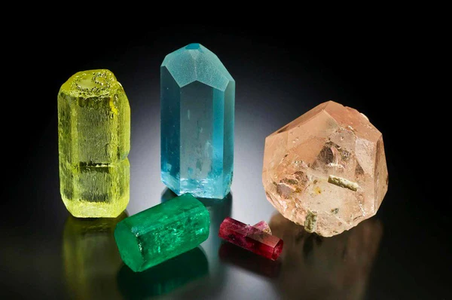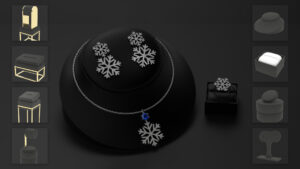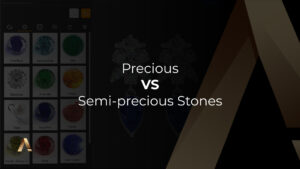You may not recognize the Beryl gemstone family by their surname, but you certainly know of some of the family’s superstars, including Emerald and Aquamarine.
Beryl is a rare silicate mineral composed of beryllium aluminum cyclosilicate. Beryl is an allochromatic mineral, which means it is colorless in its’ chemically pure form, but the smallest amounts of “coloring” agents such as metallic elements, inclusions and impurities in the crystal structure leads to color changes in the gemstone. Here you have different gemstones that are included in the Beryl Family:
GOSHENITE
Goshenite is the name given to the purest form of beryl, which was discovered in Goshen, Massachusetts. It is sometimes referred to as the “mother of gemstones” because the addition of various trace elements in nature transforms it into emerald, aquamarine, morganite, heliodor, or bixbite.

EMERALD
The most important variety of beryl is Emerald which is given its’ rich green color by the presence of chromium or vanadium. Emerald is defined by its’ very specific rich color and it is also the most important quality factor for the gemstone.
Beryls with weak saturation or light tone should be called “green beryl” rather than emerald.

AQUAMARINE
Aquamarine’s name is derived from aqua marinus, Latin for “seawater”, which is quite fitting since it is the blue to blue-green member of the beryl family. Aquamarine gets its’ blue coloring from the presence of iron. This stone has different symbols but the most important is that is a symbol of youth, hope, and health. It embodies eternal life.

MORGANITE
Morganite is the pink to orangey-pink member of the beryl family colored by the presence of manganese. Discovered in Madagascar in 1910 by George F. Kunz, the chief gemologist at Tiffany & Co. and the personal gemologist of banker J.P. Morgan, whom Kunz named the gem in his honor.

GREEN BERYL
“Green beryl” is the name given to light green beryls that do not have tone and saturation dark enough to be classified as “emerald.” These pale green beryls are colored by iron or chromium, with their color ranging from pale yellow-green to pale mint green.

HELIODOR
Heliodor is the yellow variety of beryl and it also known as “Golden Beryl” or “Yellow Beryl.” It ranges in color from greenish-yellow to orangey-yellow or yellowish-brown and is colored by the presence of iron.

RED BERYL / BIXBITE
Red Beryl is one of the world’s rarest gems and is definitely the rarest variety of the Beryl family. Ranging from a deep red to a raspberry pink, red beryl derives its’ intense color from manganese impurities, which occur in higher concentrations giving it a deep red saturation that morganite crystals never achieve. The gem was initially named “bixbite” after Maynard Bixby, who first discovered the material in 1897. That name has been mostly abandoned because it was so often confused with bixbyite, a manganese iron oxide mineral also named after Mr. Bixby.













